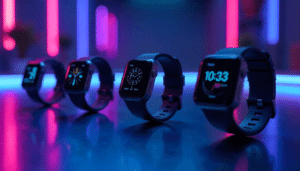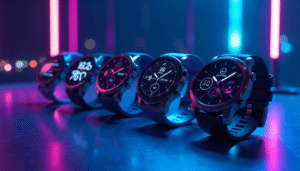The world of smartwatches is more dynamic and feature-rich than ever, offering an accessory that’s as much a personal assistant as it is a health tracker. As technology rapidly evolves, choosing the right device can feel overwhelming, but a thorough smartwatch review can illuminate the path to your perfect wrist companion. Whether you’re a fitness enthusiast, a busy professional, or simply looking to stay connected, there’s a wearable designed just for you.
This comprehensive guide dives deep into the top contenders for 2026, dissecting their features, strengths, and ideal users. Our goal is to equip you with the knowledge needed to make an informed decision, ensuring your next smartwatch purchase truly enhances your daily life. Let’s explore the cutting-edge innovations and practical benefits these devices offer, making your smartwatch review process straightforward and effective.
Understanding Your Needs: The Foundation of a Smartwatch Choice
Before diving into specific models, it’s crucial to pinpoint what you truly need from a smartwatch. Are you primarily seeking advanced health monitoring, seamless communication, or perhaps a stylish accessory that complements your lifestyle? Identifying your core priorities will significantly narrow down your options.
Many users prioritize fitness tracking, while others value extended battery life or specific app integrations. A successful smartwatch review begins with a clear understanding of your personal use case. Consider these key areas when evaluating your needs.
Key Features to Consider
Smartwatches boast an array of features, each designed to cater to different aspects of your life. Not every feature is essential for everyone, so prioritize based on what truly matters to you.
Deep Dive into the Leading Contenders: A Comprehensive Smartwatch Review

In the competitive landscape of wearables, a few brands consistently stand out, each offering unique strengths and catering to different user segments. This detailed smartwatch review focuses on the current market leaders, helping you understand their offerings.
From Apple’s seamless integration to Garmin’s fitness prowess and Samsung’s Android-centric design, there’s a strong contender for every user. Evaluating these devices requires looking beyond just specifications and considering the overall user experience.
Apple Watch Series 9 and Ultra 2
Apple continues to dominate the premium smartwatch market with its unparalleled integration into the iOS ecosystem. The Series 9 offers an upgraded S9 SiP for faster performance and a brighter display. It’s packed with health features, including ECG, blood oxygen, and temperature sensing.
The Apple Watch Ultra 2 is designed for adventurers and serious athletes, boasting a rugged titanium case, extended battery life, a customizable Action Button, and advanced GPS capabilities. Both models benefit from watchOS, providing a vast app library and intuitive user interface. For iPhone users, the Apple Watch provides the most comprehensive smartwatch review experience.
Samsung Galaxy Watch 6 and Watch 6 Classic
Samsung’s latest offerings run on Wear OS, making them excellent choices for Android users. The Galaxy Watch 6 series features a beautiful AMOLED display, robust health tracking (including body composition analysis), and the return of the beloved rotating bezel on the Classic model. They integrate seamlessly with Samsung phones but also offer a strong experience for other Android devices.
Their focus on style, customizable watch faces, and deep health insights makes them a compelling choice. This smartwatch review highlights their strong performance for Android users seeking a premium experience.
Google Pixel Watch 2
Google’s second-generation Pixel Watch refines its elegant design with improved performance and enhanced health tracking, thanks to Fitbit integration. It runs on Wear OS, offering native Google apps like Maps and Wallet directly on your wrist. The focus is on seamless Android integration and a clean, minimalist user interface.
The Pixel Watch 2 offers excellent stress tracking, continuous heart rate monitoring, and safety features. While battery life can be a concern for heavy users, its sleek design and Google ecosystem integration are major draws. This smartwatch review notes its potential for Android enthusiasts.
Garmin Forerunner and Fenix Series
Garmin remains the undisputed king for serious athletes and outdoor enthusiasts. Their watches prioritize accuracy in GPS, heart rate, and advanced physiological metrics. Models like the Forerunner series are lightweight and feature-rich for runners, while the Fenix series offers ruggedness, mapping, and incredibly long battery life for multi-sport adventures.
While not as “smart” in terms of app ecosystem as Apple or Samsung, Garmin excels at what it does best: providing unparalleled data for training and exploration. The extensive battery life on many Garmin models is a significant advantage in any comprehensive smartwatch review.
Comparison of Top Smartwatches
| Product | Price | Pros | Cons | Best For |
|---|---|---|---|---|
| Apple Watch Series 9 | $399 – $499 | Seamless iOS integration, advanced health sensors, vast app ecosystem | Requires iPhone, 18-hour battery life (typical) | iPhone users prioritizing health, communication, and apps |
| Apple Watch Ultra 2 | $799 | Exceptional durability, multi-day battery, brightest display, advanced GPS | High price, bulky for small wrists, requires iPhone | Outdoor adventurers, serious athletes, iPhone users needing extreme durability |
| Samsung Galaxy Watch 6 Classic | $399 – $429 | Classic rotating bezel, comprehensive health tracking, good Android integration | Shorter battery life than some competitors, best with Samsung phones | Android users valuing style, health, and a tactile interface |
| Google Pixel Watch 2 | $349 – $399 | Sleek design, deep Fitbit integration, native Google apps, improved performance | Limited battery life, only compatible with Android, proprietary band connector | Android users seeking a minimalist design and strong Google/Fitbit integration |
| Garmin Fenix 7 Pro | $699 – $899 | Multi-week battery life, robust build, unparalleled sports tracking, maps | Limited “smart” features (apps/payments), high price | Serious athletes, hikers, outdoor enthusiasts needing extensive data and battery |
Beyond the Basics: Advanced Features and Ecosystems
Modern smartwatches go far beyond telling time and counting steps. They are sophisticated personal assistants capable of enriching various aspects of your life. A thorough smartwatch review must also consider these advanced capabilities.
Understanding how these features integrate into your daily routine can be the deciding factor in your purchase. The software ecosystem supporting the hardware is just as important as the physical device itself.

Cutting-Edge Health Monitoring
These features turn your smartwatch into a powerful health companion, providing data that can be shared with healthcare professionals. This level of detail elevates any smartwatch review.
Smart Home and Digital Assistant Integration
Your smartwatch can become a control hub for your smart home. With devices running Wear OS or watchOS, you can
This seamless integration into your digital life adds a layer of convenience that is hard to beat. It’s a key aspect to consider in a comprehensive smartwatch review for tech-savvy users.
Payment Systems and On-Wrist Convenience
Leaving your wallet at home is increasingly viable thanks to NFC payment capabilities. Apple Pay, Google Pay, and Samsung Pay allow you to make secure purchases with a tap of your wrist. This is invaluable for quick errands or when you’re out for a run without your phone.
Beyond payments, the ability to store music, view maps, and control media playback all from your wrist contributes to an unparalleled level of convenience. The evolution of these features makes for a compelling smartwatch review, highlighting true freedom from your phone.
Battery Life, Durability, and Design: Practical Considerations
While features are important, the practical aspects of daily wear—how long it lasts, how tough it is, and how it looks—are equally critical. A good smartwatch review evaluates these factors against your lifestyle.
No one wants a device that dies halfway through the day or can’t withstand a light rain shower. The aesthetics of a wearable also play a significant role, as it’s an extension of your personal style.
The Battery Life Dilemma
Battery life is perhaps the most common differentiator and complaint among smartwatch users. Some devices offer multi-week endurance, while others require daily charging. Your choice here depends heavily on your usage.
Consider your personal tolerance for charging when conducting your smartwatch review. An ultra-long battery life can be a game-changer for some.
Built to Last: Durability and Water Resistance
Your smartwatch is exposed to the elements and daily bumps. Durability is paramount. Look for watches made from resilient materials like stainless steel, titanium, or reinforced aluminum. The display glass is also crucial, with Sapphire Crystal offering superior scratch resistance over standard glass.
Water resistance ratings, typically measured in ATM (atmospheres), indicate how deep a watch can go.
If you’re an avid swimmer or participate in water sports, ensure your chosen device meets your water resistance needs. This is a critical aspect of any practical smartwatch review.
Style and Personalization
A smartwatch is also a fashion accessory. Manufacturers offer a variety of case materials, colors, and an extensive range of interchangeable straps. From sporty silicone bands to elegant leather and metal bracelets, you can customize your watch to suit any occasion.
Furthermore, the ability to personalize watch faces allows you to change the aesthetic and functionality of your display. Some offer thousands of options, from minimalist to information-rich. Personal style should certainly be part of your smartwatch review process.
Making Your Final Decision: A Strategic Smartwatch Review Process
With so many excellent options available, making a final choice requires a structured approach. This section guides you through narrowing down your selections based on the insights gained from this comprehensive smartwatch review.
Consider your budget, current smartphone, and long-term goals for using a wearable. A careful evaluation now can prevent buyer’s remorse later.
1. Align with Your Smartphone Ecosystem
This is often the most straightforward decision point. If you have an iPhone, an Apple Watch is almost always the superior choice due to seamless integration and exclusive features. For Android users, Samsung Galaxy Watches or Google Pixel Watches offer the best experience with Wear OS. While some smartwatches are cross-compatible, the full functionality and user experience are often tied to their native ecosystem.
2. Prioritize Your Core Use Case
Revisit your initial needs. Is fitness tracking your absolute priority? Garmin might be your best bet. Do you need a seamless extension of your smartphone for calls, texts, and apps? Apple Watch or Samsung Galaxy Watch excel here. Do you want advanced health metrics and elegant design? Many premium models offer this.
Don’t pay for features you won’t use. A detailed smartwatch review should help you identify which features are essential for you.
3. Set a Realistic Budget
Smartwatch prices range from under $100 to over $1000. While premium models offer the latest features and materials, excellent devices exist at every price point. Consider the value proposition for each device:
Sometimes, opting for a slightly older generation can save you money while still providing a fantastic experience. Many features from last year’s flagship are still highly competitive today. This is a smart approach for any smartwatch review on a budget.
4. Read User Reviews and Hands-On Impressions
While expert reviews (like this smartwatch review) provide technical details and comparisons, user reviews offer invaluable insights into real-world performance, durability, and customer service. Look for common praises and complaints to get a balanced perspective. If possible, try on different models in person to assess comfort and aesthetics.
5. Future-Proofing Your Purchase
Technology evolves rapidly, but you can make choices that extend the life of your device. Consider watches with a strong track record of software updates, good repairability, and widely available accessories. Opting for a cellular model, even if you don’t activate the plan immediately, gives you more flexibility down the line.
By carefully weighing these factors, you can confidently select the perfect wearable to accompany you throughout 2026 and beyond.
Choosing the ultimate smartwatch in 2026 boils down to understanding your personal needs and aligning them with the right device’s strengths. From the seamless integration of the Apple Watch for iPhone users to the athletic prowess of Garmin and the Android-centric design of Samsung and Google, there’s a perfect fit for everyone. Prioritize your budget, desired features, and smartphone ecosystem to make a confident decision. Remember that the best smartwatch isn’t necessarily the most expensive, but the one that best enhances your daily life and helps you achieve your goals. This comprehensive smartwatch review aims to empower you on that journey, providing clarity in a complex market.
For more insights or collaboration opportunities, visit www.agentcircle.ai.
Frequently Asked Questions (FAQ)
Q: What is the average battery life of a modern smartwatch?
A: The average battery life varies significantly. Premium smartwatches with advanced displays and features (like Apple Watch, Google Pixel Watch) typically last 18-36 hours, requiring daily charging. Fitness-focused watches (like Garmin) can last several days to multiple weeks, depending on usage and features like GPS tracking.
Q: Are smartwatches compatible with all smartphones?
A: Not always. Apple Watches are exclusively compatible with iPhones. Most Wear OS smartwatches (Samsung Galaxy Watch, Google Pixel Watch) are best with Android phones, though some offer limited iOS compatibility. Always check the specific compatibility requirements before purchasing.
Q: Can I make calls and send texts without my phone using a smartwatch?
A: Yes, if the smartwatch has cellular (LTE) connectivity. These models require a separate cellular plan from your mobile carrier, usually an extension of your existing phone plan. Non-cellular smartwatches can make calls and send texts when connected via Bluetooth to your nearby smartphone.
Q: Are the health tracking features on smartwatches accurate enough for medical purposes?
A: Smartwatch health features, such as ECG and SpO2 monitoring, can provide valuable insights and detect potential issues, often with FDA or CE clearance. However, they are generally designed for wellness and informational purposes, not as medical diagnostic tools. Always consult a healthcare professional for any health concerns.
Q: What’s the difference between GPS and built-in GPS on a smartwatch?
A: All smartwatches can use GPS data. “Connected GPS” means the watch relies on your smartphone’s GPS when nearby. “Built-in GPS” means the watch has its own GPS receiver, allowing it to track your location and distance for activities like running or cycling without needing your phone present.
Q: Is it worth buying a smartwatch just for fitness tracking?
A: Yes, absolutely. Many people buy smartwatches primarily for fitness and health tracking. Devices like Garmin, Fitbit, and even specific Apple Watch models offer incredibly detailed metrics, workout tracking, recovery insights, and long-term health monitoring that can be highly motivating and beneficial for achieving fitness goals.
References and Further Reading
https://www.apple.com/apple-watch
https://www.samsung.com/us/watches
https://store.google.com/product/pixel_watch_2




